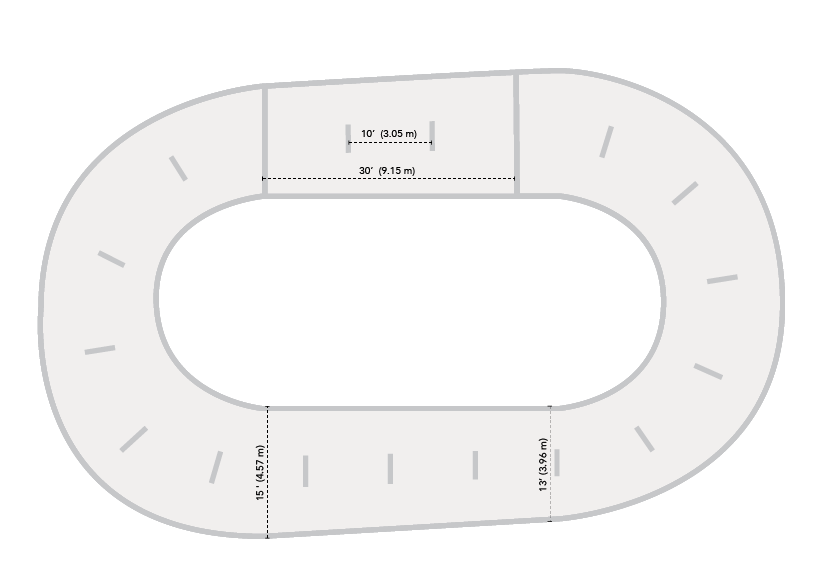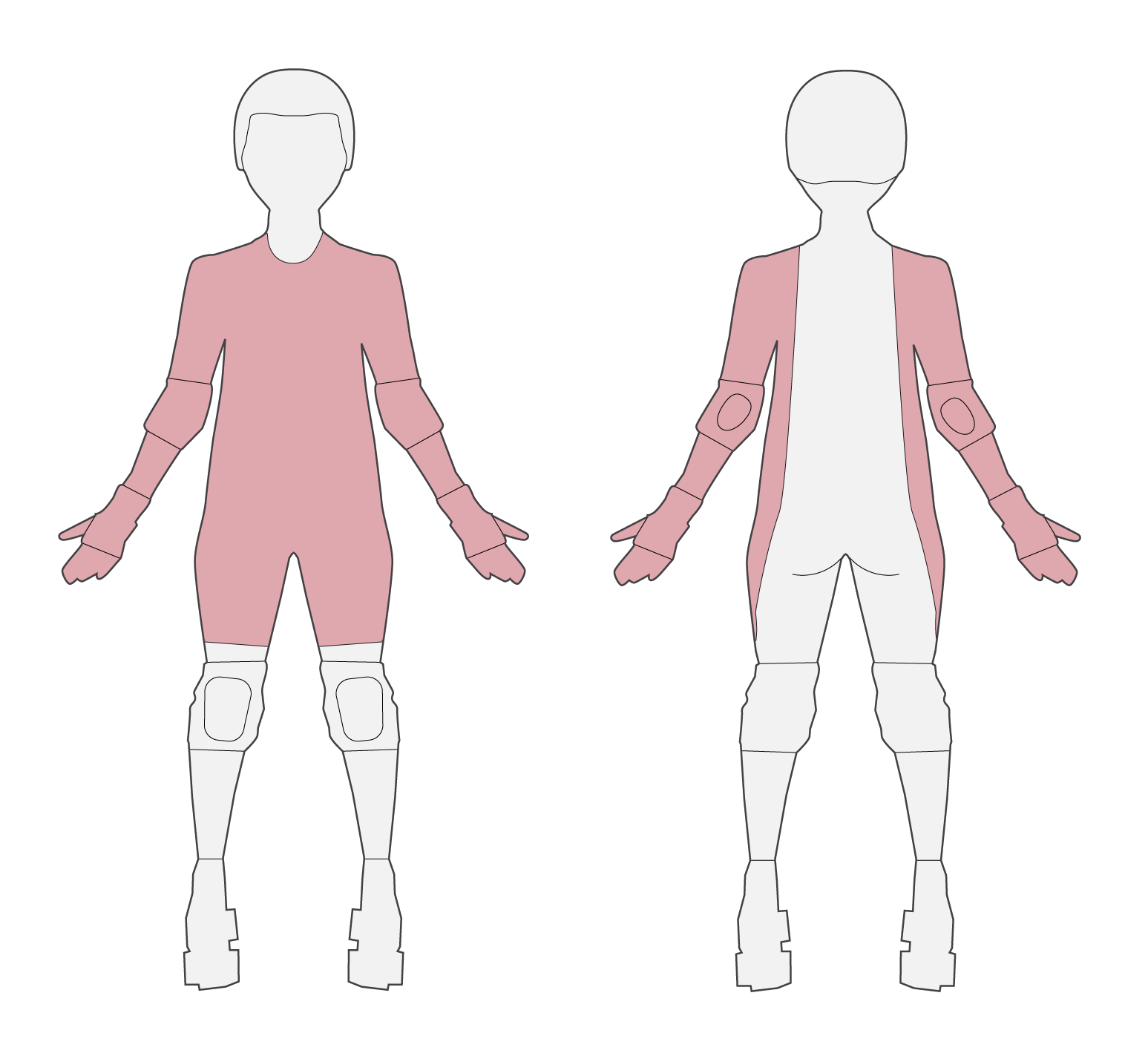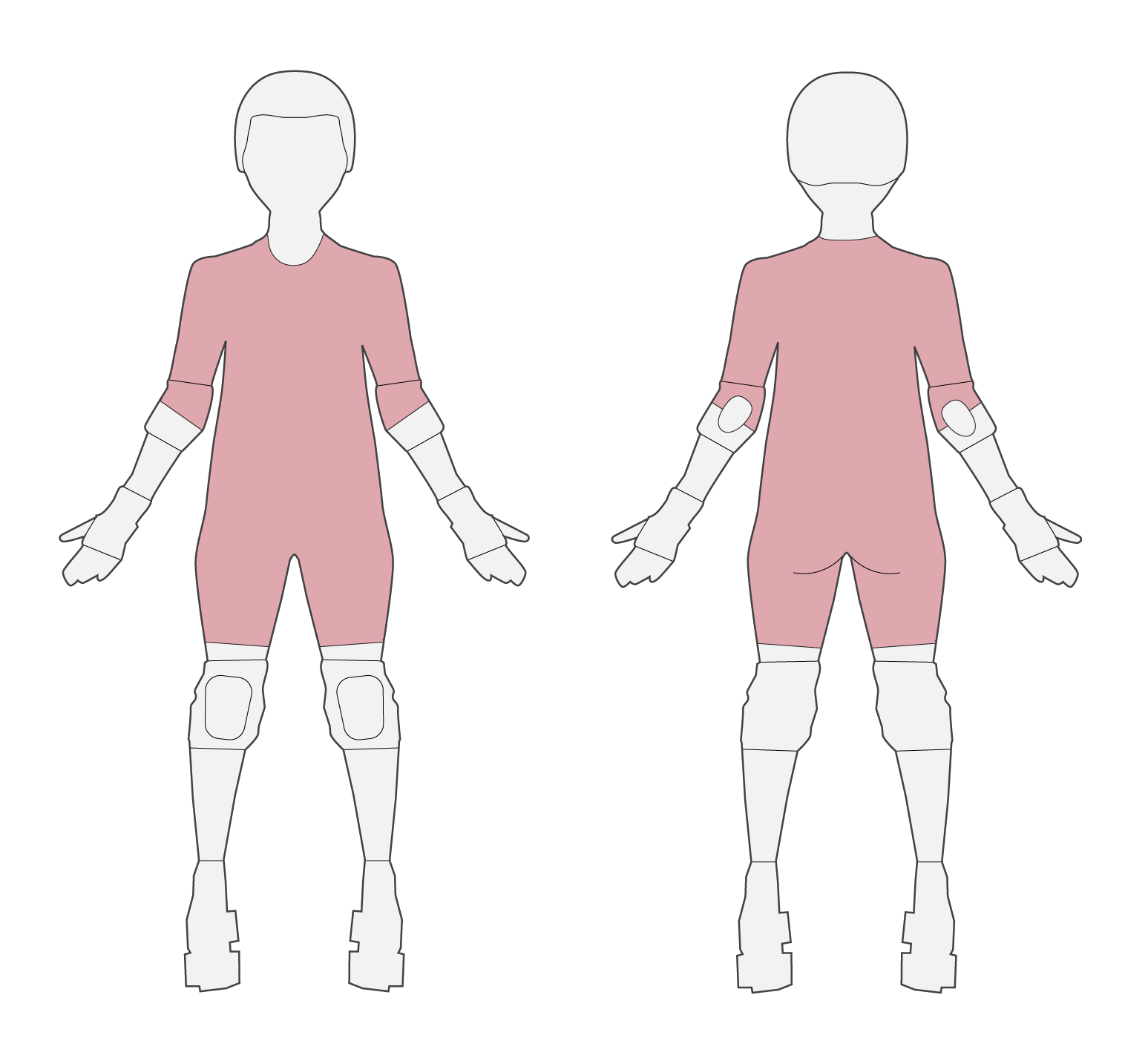2. Gameplay¶
2.1. Der Track¶
The track must conform to the standardized dimensions of the WFTDA Track Specifications. (Abb. 2.1) The track must be flat, clean, and suitable for roller skating.
Boundary Lines
The track must be marked by a boundary that stands in high contrast to the floor. The boundary counts as part of the track (the boundary is „in bounds“) and may not vary in width around the track. The track boundary, Pivot Line, and Jammer Line may be of any pattern or color so long as they clearly mark the edge of the track.
Penalty Box and Team Areas
Near the track, an area must be marked out for each team (the Team Bench Area) and for the Penalty Box. The boundary in these cases must also be high contrast and counts as part of the relevant area. For example, the boundary for the Penalty Box counts as part of the Penalty Box. Only Skaters who are actively serving a penalty may enter the Penalty Box Area.

Abb. 2.1 The Track (Track Layout and Design © 2002 Electra Blu/Amy Sherman, Texas Rollergirls, used here with permission)¶
2.2. Skater Roles¶
For each Jam, a team must field one Jammer, and at most four Blockers. One of these Blockers may be designated as the Pivot. Any Skaters who are not completely on the track at the Jam-Starting Whistle may not participate in the Jam, and do not count toward these limits. Skaters serving penalties (in, or on their way to, the Penalty Box) are counted toward these limits. Teams must field at least one Blocker who is not serving a penalty. Skaters may not change Roles during a Jam, except in the case of a Star Pass (see below).
2.2.1. Jammer¶
The Jammer is denoted as the Skater in visible possession of the Jammer helmet cover (a.k.a. the Star) at the beginning of the Jam.
Identification
The Jammer for the upcoming Jam is determined based on this order:
The Jammer from the previous Jam who is in, or en route to, the Penalty Box
The Skater who visibly controls the Star, who has lined up in the Jammer Starting Position
The Skater who visibly controls the Star, who has lined up In Bounds, but out of position
If no Skater from a team satisfies any items in this list, that team has not fielded a Jammer, and the Jam should not start. If multiple Skaters from a team satisfy the same item in the list, that team is acting in an illegal way, and the Jam should not start.
Controlling the Star
The Star may only be carried by the Jammer wearing it on their helmet, or by that team’s Jammer or Pivot holding it in their grasp. Other Skaters may not control the Star, and the Jammer and Pivot may not hide the Star (for example, putting it in a pocket or hiding it in a uniform).
Jammer Privileges
The Jammer is the only Skater who can score points for their team (see Abschnitt 3). Jammers may also legally exit and remain outside of the Engagement Zone.
2.2.2. Lead-Jammer¶
The Lead Jammer (Lead) is the first eligible Jammer who establishes superior position to the foremost in-play Blocker, having already earned a pass on all Blockers excluding those ahead of the Engagement Zone (see Abschnitt 2.5). When one Jammer is determined to be the Lead Jammer, this is indicated by two short whistle blasts. If both Jammers qualify for Lead at the same moment (for example, if the foremost Blocker goes Out of Play), the foremost Jammer at that moment will be declared Lead.
Lead Eligibility
Both Jammers begin each Jam eligible to earn Lead Jammer status during that Jam. A Jammer becomes ineligible to earn Lead during a Jam if they commit a penalty during that Jam or the Lineup Time before that Jam, exit the front of the Engagement Zone without having earned Lead on their initial trip, remove their helmet cover, or have their helmet cover removed by a teammate. Only Skaters who begin the Jam as Jammers may become Lead (so a Pivot who receives the Star cannot become Lead).
Loss of Lead Jammer Status
The Lead Jammer will lose their Lead Jammer status if they commit a penalty, intentionally remove the Star once it is on, or have the Star intentionally removed from their head by a teammate. Lead Jammer status is maintained if the Star is removed via natural gameplay or is pulled off by an opponent.
Calling Off the Jam
The Lead Jammer is the only Skater who may call off a Jam before the full two minutes elapse. The Lead Jammer calls off the Jam by repeatedly placing their hands on their hips. The Lead Jammer retains the ability to call off the Jam even if they are not wearing the Star.
2.2.3. Pivot¶
The Pivot is a Blocker, and is denoted as the Skater in possession of the Pivot helmet cover (a.k.a. the Stripe) at the Jam-Starting Whistle. The Pivot wearing the Stripe with the stripe showing has several additional abilities that other Blockers do not.
Der Pivot kann zum Jammer des Teams werden (siehe Abschnitt 2.2.4).
The Pivot may control the Star (pick it up, move it, etc.)
Der Pivot darf beim Jam-Start die Pivot-Linie berühren.
When not wearing the Stripe with the stripe showing, the Pivot cannot utilize these additional abilities. Only the Pivot may legally control or wear the Stripe.
2.2.4. Star-Pass¶
A team’s Jammer may transfer their Role to their team’s Pivot by successfully completing a legal Star Pass. A legal Star Pass requires the Jammer to hand the Star to their team’s Pivot while both Skaters are Upright, In Bounds, and In Play; and while neither Skater is en route to, or In Queue for, the Penalty Box. Upon releasing the Star into the Pivot’s grasp, the Role of Jammer is transferred to the Pivot. The new Jammer takes over for the previous Jammer in terms of points scored, trips through the Pack, and Skaters passed. The previous Jammer becomes a Non-Pivot Blocker.
Illegal Star Passes
If the Star is passed illegally, both Skaters retain their existing Roles. This includes:
Releasing the Star into the grasp of a Skater other than their Pivot
Releasing the Star into the Pivot’s grasp while either of the two Skaters is Down, Out of Bounds, Out of Play, or en route to the Penalty Box
Releasing the Star into the Pivot’s grasp while the Pivot is In Queue for the Penalty Box (even if the Pivot is not yet en route)
Releasing the Star into the grasp of a Pivot who is not wearing the Stripe
The initiator of an illegal Star Pass that impacts the game should be penalized.
Pivot Controlling the Star
If the Pivot comes into control of the Star though any means other than a legal Star Pass, they will be warned that they are not the Jammer. The Pivot may not put the Star on their own helmet, but they may hold the Star in their hand, drop it, or return it to the Jammer. Only the Jammer or Pivot may recover or control the Star.
2.2.5. Blocker¶
All other Skaters are considered Blockers. Non-Pivot Blockers‘ helmets or helmet covers may not have any markings that could be confused for the Stripe or the Star.
2.2.6. Skater Starting Locations¶
Skaters start each Jam in the following locations on the track:
Jammers must be behind or touching the Jammer Line.
Blockers must be behind the Pivot Line and ahead of the Jammer Line.
Additionally, Pivots may be touching the Pivot Line.
If either Pivot is touching the Pivot Line, all non-Pivot Blockers must be behind that Pivot.
Illegally Positioned Skaters
Any skater who is In Bounds at the start of the Jam but is touching entirely out of their designated starting location should be penalized.
False Starting Skaters
Skaters in the following states at the Jam starting whistle are considered to have committed a False Start:
A fully In Bounds Skater who is touching both inside and outside their designated starting location
A non-Pivot Blocker whose hips are ahead of those of a Pivot who is touching the Pivot Line.
A Jammer who is gaining speed in the counterclockwise direction at the Jam start.
False starting skaters are required to yield their position to all other Skaters in the immediate vicinity. Blockers who are required to yield are not considered for Pack definition until they have done so. Jammers who are required to yield cannot earn passes until they have done so.
2.3. Pack & Engagement Zone¶
The Pack is the largest group of In Bounds and Upright Blockers in proximity and containing members from both teams. If no single group of Blockers meets this definition, there is no Pack, even if there are multiple groups of the same size. Proximity is defined as not more than 10 ft (3.05m), in front of or behind the nearest Pack Skater. When a Skater is penalized, they are considered to no longer be on the track for the purposes of Pack definition and relative position determinations.
Die Entfernungen für die Bestimmung des Packs und der Engagement-Zone werden als die kürzeste Distanz zwischen den Hüften der Skater parallel zur inneren Trackbegrenzung gemessen.
Maintaining the Pack
It is the responsibility of all Blockers to maintain a Pack, and intentionally destroying the Pack is illegal. When the Pack is moving counterclockwise, stopped, or has no established speed, clockwise skating which destroys the Pack is illegal.
Reforming the Pack
When there is no Pack, all Blockers from both teams must act to reform a Pack. For Skaters in the rear group, this includes stepping or skating in the counterclockwise direction. For Skaters in the front group, this includes coasting, braking, or coming to a complete stop.
If an immediate action is not sufficient to reform the Pack, additional effort is required. If a Blocker is in the rear group, they must accelerate (until sprinting) toward the front group until a Pack is reformed (coasting, stepping slowly, or stepping in an only somewhat counterclockwise direction are insufficient), but they may slow in order to avoid unsafe contact when the Pack reformation is imminent. If a Blocker is in the front group, they must actively brake until they come to a complete stop (coasting is insufficient), but they are not required to skate clockwise.
Blocking Without a Pack
Blocks on or by Blockers which have impact while there is no Pack should be penalized.
Engagement Zone
The Engagement Zone is the area in which it is legal for Blockers to engage or be engaged. The Engagement Zone extends forward and backward 20 ft (6.10m) from the foremost and rearmost Pack Skaters, respectively. Any Blocker outside of the Engagement Zone is Out of Play and cannot engage or be engaged.
Returning to the Engagement Zone
Blockers who are outside of the Engagement Zone will be warned, and will be penalized if they do not immediately attempt to return to the Engagement Zone. Blockers ahead of the Engagement Zone are only compelled to skate clockwise to return to the Engagement Zone if the Pack is stopped or moving clockwise.
Blocking while Out of Play
Skaters who are illegally blocked while Out of Play may legally counter-block, but may not initiate new blocks or continue blocking beyond what is necessary for safety.
Blocking while Out of Bounds
Skaters who are blocked while completely Out of Bounds may actively absorb the block, but may not continue counter-blocking beyond that, and may not initiate a new block.
2.4. Blocks und Assists¶
During a Jam, „Blocking“ refers to any attempt at making physical contact to impede an opponent’s speed or movement, whether or not contact occurs. ‚Positional Blocking‘ refers to any attempt to position oneself so that an opponent’s speed or movement is impeded without the use of contact, whether or not the action is successful.
Initiation
All contact between opponents has an initiator. It is possible for two or more Skaters to mutually initiate blocks against one another.
2.4.1. Target-Zonen¶
It is only legal to initiate a block to an opponent’s chest, front and sides of the torso, arms, hands, hips, and the front and sides of the legs above mid-thigh.

Abb. 2.2 Legale Target-Zonen¶
2.4.2. Blocking-Zonen¶
Es ist nur erlaubt, jemanden mit dem Oberkörper, den Oberarmen und den Beinen oberhalb der Mitte des Oberschenkels zu blocken.

Abb. 2.3 Legale Blocking-Zonen¶
2.4.3. Counter Blocking¶
Counter-blocking is any movement towards an oncoming block by the receiving Skater designed to counteract an opponent’s block. Counter-blocking is blocking. Actions that meet the above description are considered blocking, even if accidental. Contact made to teammates is not considered blocking even if it is a disadvantage to the initiator or teammate.
2.4.4. Illegal Blocks and Assists¶
Skaters may not block or assist while Out of Bounds, Out of Play, down, stopped, or moving clockwise. Skaters also may not initiate a block on an opponent who is down, Out of Play, or fully Out of Bounds. Skaters may, however, initiate a block (or assist) on someone who is straddling, stopped, or moving in any direction (even clockwise). Skaters may not assist a teammate who is Out of Play or fully Out of Bounds; however, they may assist a downed teammate in returning to an Upright position.
2.5. Passieren¶
Skater erreichen eine überlegene Position gegenüber anderen Skatern, indem sie sie gegen den Uhrzeigersinn überholen.
Einen anderen Skater zu passieren bedeutet, dass sich der Körperschwerpunkt (zwischen den Hüften) des Skaters von hinter dem Körperschwerpunkt eines anderen Skaters zu davor bewegt.
Earned Passes
Jammers only „earn“ a pass if the pass occurs while the Jammer is wearing the Star on their helmet with the stars showing and:
The Jammer is Upright and In Bounds during the pass, or
Another Skater skates behind the In Bounds Jammer, giving up their position.
All earned passes count as passes.
Not on the Track Points
As soon as a Jammer earns a pass on an opposing Blocker, they also earn a pass on any Blockers who are „not on the track“–meaning that they are not part of active gameplay for some reason–and who cease to be a part of active gameplay prior to the completion of the Jammer’s scoring trip. This includes Skaters who:
Are sent to or serving time in the Penalty Box
Leave the track due to injury
Leave the track temporarily to fix equipment or skates
Were not part of the Jam in the first place (because their team did not field the maximum number of Skaters)
Return to active gameplay behind the Jammer
Airborne Passes
A Skater who passes someone while airborne is considered to be „in bounds“ if they are In Bounds when they leave the floor and the first contact they make upon landing is In Bounds. A Skater who passes someone while airborne is considered to be „upright“ if the Skater is Upright when they leave the floor, and if the first contact they make upon landing is with their skate to the floor.